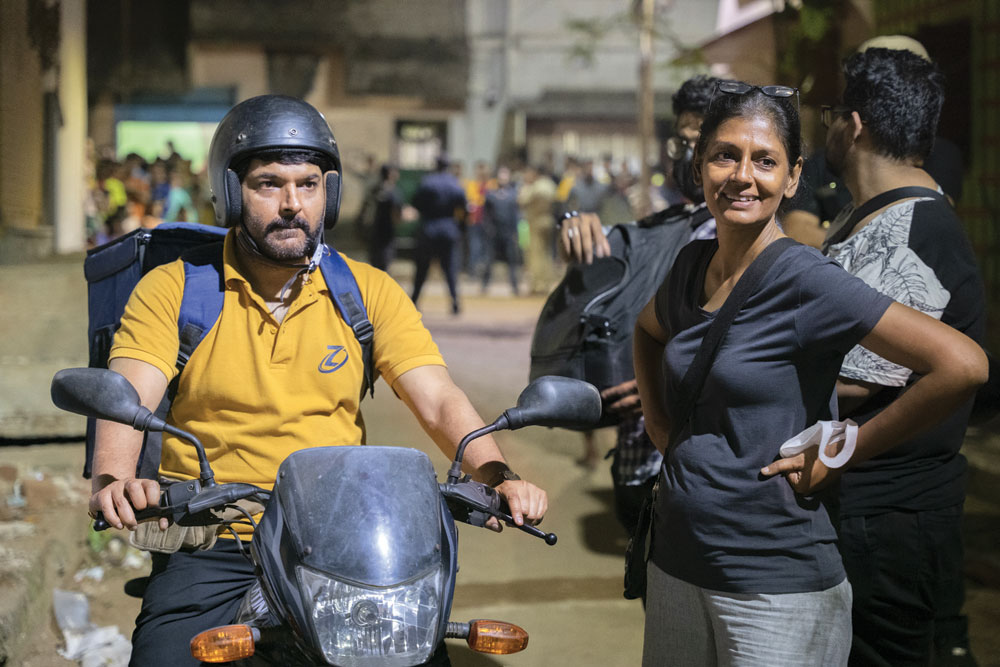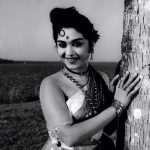Das Capital
Nandita Das chronicles the struggles of blue-collar workers in her third film. The filmmaker tells why she chose to focus on the gig economy
 Kaveree Bamzai
Kaveree Bamzai
 Kaveree Bamzai
Kaveree Bamzai
 |
24 Mar, 2023
|
24 Mar, 2023
/wp-content/uploads/2023/03/Dascapital1.jpg)
Nandita Das
SHE STARTED AS she meant to continue. It was in 1989, there was a strike in Delhi University where Nandita Das was studying. Filmmaker Prakash Jha offered her a guest appearance that was pivotal to his film, Parinati. He had heard of her through the late great actor Surekha Sikri, who played the lead in the film. She had seen Das act in a street play and thought she would be suitable for the part. “I took up the role for the experience of it. It was amazing to play this intense character in the freezing cold desert of Rajasthan. During the shoot, we experienced one of the worst hailstorms ever, and we were all living in tents. So, you can imagine the fear and excitement,” says Das.
For several years after that, she had no idea that she would act more in films, let alone become one of pan-Indian cinema’s leading lights starting with her first leading role as a young middle-class woman who discovers she loves her sister-in-law in Deepa Mehta’s Fire (1996). She has created a formidable filmography not merely as an actor but as a director, with her third film, her most accomplished yet, Zwigato, a searing critique of the dehumanisation inherent in the gig economy. Starring the popular comedian Kapil Sharma, the film is a gentle but powerful chronicle of the lives of those on the margins of our urban consciousness, the delivery men and the masseuses, the cleaners and the cooks. Shot in her home state of Odisha, it features Sharma as Manas, a Zwigato delivery rider, and his wife, Pratima, played by the luminous Shahana Goswami, struggling to maintain their family of four in a post-Covid world.
It is a world in which old-style inequalities co-exist with high-tech opportunities. A potential client can’t bear the sweat in the sari-clad Pratima who has come to give her a massage. A board outside the lift in an apartment complex announces that delivery boys have to use the stairs. Manas’ daughter who studies in an English-medium school complains about his line of work and his way of dressing—T-shirts are meant to be worn only with jeans, she says. And a prospective employer at a construction site tells Manas he may well have to do some heavy lifting like a labourer occasionally.
“Nandita is an amazing storyteller. Like a renaissance artist, she has this unique ability to see the unseen and invisible, and then paint these extraordinarily richly detailed pictures of what most others would call ordinary. With Zwigato, she takes us up close to everyday stories about wide swathes of less privileged Indians, and ends up holding a mirror up to all of us,” says Sameer Nair, the movie’s producer and CEO, Applause Entertainment. The movie, which released last week, has been getting rave reviews and had already caught the imagination of viewers at the Toronto International Film Festival last year.
Partly because of her training in social work in a post graduate programme, and partly because of her artistic parents (father Jatin is a painter and mother Varsha a publisher), Das has always maintained a quiet distance from the fanfare that comes with stardom. It was there for her, waiting, especially after co-starring with Aamir Khan in the Deepa Mehta film, 1947 Earth in 1998. Khan offered Indra Kumar’s Mann to her but in the very first photoshoot they put so much makeup on her that she looked lighter skinned than him. “That itself told me,” she says, “that mainstream cinema was not for me.” As for her roles as Amitabh Bachchan’s wife in Aks (2001) and the avenging Paro in Pitaah (2002), films of the two filmmakers, Rakeysh Omprakash Mehra and Mahesh Manjrekar. “What bothered me more than what was portrayed on screen was the inherent hierarchies, especially when one is on the top of the hierarchy as I was playing the female lead,” she says.
“The more women are behind the camera, the more change it will bring to how we perceive women on camera. This will also impact the stories we are choosing to tell,” says Nandita Das, filmmaker
Things in the film industry are a little better now and though she has been consumed by direction, she hasn’t shut herself to good roles. After all, she owes it to her filmography of 40-odd films, which she did for many different reasons. “In some films, the experience was precious while others were important simply because the story was worth telling,” she says. Not all turned out the way she had imagined, but for her, the journey is as important as the end, so she can’t really separate the two. There was Deepa Mehta with whom she closely worked on two films, Fire and 1947 Earth; Mrinal Sen (Aamar Bhuvan, 2018) whose stories she loved listening to; Mani Ratnam (Kannathil Muthamittal, 2002), for his passionate style of working; Santosh Sivan (Before the Rains, 2007) for his creative eye; Adoor Gopalakrishnan (Naalu Pennungal, 2007) for his uncompromising approach to cinema; and Shyam Benegal (Hari-Bhari, 2000) for his intellect and warmth. “And also first-time directors like Chitra Palekar (Maati Maay, 2006) and Kavitha Lankesh (Deveeri, 1999), for their passion and commitment (and I know how difficult it is to make your first film, and at the time, more so for women). And Suman Ghosh, for giving me the opportunity to work with Soumitra Chatterjee in Podokkhep (2006),” she says. Sivan still remembers the magic of working with her on Before the Rains: “She is an amazing actress and a very fine human being. But it’s hard to define her, she keeps springing surprises . She is still a mystery.”
The films have impacted her in different ways. Working in Fire made her aware that ‘othering’ is a deep prejudice and responding to that has become a thread in most of her films, both as an actor and a director. 1947 Earth made her understand Partition and subconsciously took her towards her second feature film, Manto (2018). Bawandar (2000) was an intense experience of playing a victim of a gang rape who slowly transforms into an activist, based on the life of Bhanwari Devi who is still fighting for justice. It was a huge responsibility. In Deveeri, she played a slum woman whose relationship with her kid brother was very nuanced. This helped her in writing Zwigato with characters who belong to a different world but they are not alien to her as she’s seen different milieus through her acting experiences and social work days.
Indeed, the many influences in her life were more than obvious in the special screenings she had in Delhi and Mumbai for Zwigato, the former studded with friends from the field of academics and social activism, and the latter full of the many actors and directors who admire her. Take Raja Menon. The director still cannot understand how a big star like her agreed to work in what he calls his “super indie” Bas Yun Hi (2003), The only explanation I can come up with is that she was looking for new challenges and had to the guts to go for it. She brought a certain gravitas to the film and I learnt a lot on that project working with an actor of her quality and experience. She’s taken chances and been adventurous and that’s amazing especially after you get the kind of stardom she got early in her career.”

HER EXPERIENCES HAVE infused the movies she has directed. “The way I see it,” she says, “I tell human stories, and as humans, we don’t live in isolation. Therefore, context becomes just as important as the individual stories themselves. To me, the personal is political and vice versa. By personal, I don’t necessarily mean my own lived experiences. What I mean is that the stories I tell are deeply rooted in issues that disturb me, or that I care enough about to engage with for years to come, as that is how long it takes to make a film. For example, Firaaq (2008) and Manto are stories about people and their relationships during times of violence and communal strife.” Zwigato, on the other hand, is a story about the relentlessness of life in the age of the gig economy, where the struggle between man and machine that Charlie Chaplin depicted in Modern Times has shifted to a struggle between man and algorithms.
Our prejudices, struggles, fears, and what we do to each other in difficult times are all of deep concern to her, and that is what compels her to make films. It is also what has made her a global champion of change in the way stories are told and heard. She has been a member of the Cannes Film Festival Jury twice in 2005 and 2013 and was a part of the celebration of women’s representation and the plea for change at the 71st Annual Cannes Film Festival. Only 82 films had been directed by women in the official selection in all those years, as opposed to 1,645 by male filmmakers. President of the Cannes Film Festival between 2001 and 2014, Gilles Jacob, has personally been very supportive of her. “While female representation behind the camera has been skewed for many decades and there is a long way for it to be truly equal, considering we hold up half the sky, we are definitely on our way,” she says. “I see a lot of young assistants and girls in film schools who in 10 years will have significant roles behind the camera. It has got more traction in the West where many of the top actors are making it mandatory to have more women in the crew. In other parts of the world, where societies are inherently patriarchal it is a slow process. The change is happening in society and I am sure that will also reflect in the film industry. The more women are behind the camera, the more change it will bring to how we perceive women on camera. This will also impact the stories we are choosing to tell,” she adds.
At 53, she has already spent 34 years behind and in front of the camera. Each form of expression challenges and excites her in different ways. As an actor, the story that is being told and the director who is going to envision it, has a greater pull for her than the role itself. But playing a host of different women that have complex journeys has definitely enriched her as a person. Being part of different films took her to so many unseen parts of the country and she met people from different milieus. Those experiences have stayed with her. “That’s the fun of investing in journeys without worrying about where it’s taking you,” she says.
“The stories I tell are deeply rooted in issues that disturb me, or that I care enough about to engage with for years to come, as that is how long it takes to make a film,” says Nandita Das
“Directing is far more consuming and obviously very different from acting. As an actor you are only privy to the shoot. Whereas when I am making a film, I am engaging with it right from its inception to its fruition. And that is why, despite many challenges, it is a very fulfilling journey. Every aspect of the filmmaking journey—writing, gathering crew, casting, shooting, editing, working on sound and music, graphics—all of it pushes my creative boundaries. I am not a trained actor or director so I rely a lot on my instinct, which has been nurtured by my varied life experiences. No bigger teacher than that,” she says.
Her life has been lived on her own terms, with her own rules. “My wrinkles, under-eye bags, all of these markers of life fully lived are out there. And there is no reason to shy away from it. I recently went to a dermatologist, my first-ever visit, and she told me I had come 10 years too late. She suggested a whole lot of invasive surgeries and I quickly made a U-turn. I came back home and looked at the mirror more carefully than I had done in a very long time. She managed to make me feel ‘less’ as some of them would want us to feel for better business prospects. One of the things we must do as women, is free ourselves from how we look, as it is just a tiny part of who we are,” she says. She knows it is easier said than done. Women have been objectified for so long that they too have internalised that pressure. She says she doesn’t diet or exercise. Nor is she in love. “I’m just too busy to be thinking about it. It is 11th on my priority and I’m barely able to do the first four things I want to do. If there is a secret at all, maybe this is one,” she says, with a laugh.
A devoted single mother to a 12-year-old boy, she has always worked on the periphery of the film industry, and yet has been in memorable movies with classic directors. Now she is making movies that make people think. It is a life well lived.
About The Author
MOst Popular
3

/wp-content/uploads/2025/07/Cover-Shubman-Gill-1.jpg)












More Columns
Nimisha Priya’s Fate Hangs In Balance, As Govt Admits It Can’t Do Much Open
Roots of the Raga Abhilasha Ojha
An Erotic Novel Spotlights Perimenopause Nandini Nair